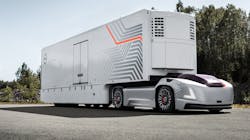After its debut in 2015 in Las Vegas, the autonomous commercial vehicle has been making waves in the trucking industry. Some skeptical, some awed, some practical and some cautiously optimistic. Trucking journalist Jack Roberts and autonomous and safety systems expert CEO and President of PrePass Mark Doughty discussed in a FleetOwner webinar the future of autonomous trucks, how soon they will be on the road and the questions the public still has about its implications to the job force.
“Computers like predictability,” said Roberts when explaining the autonomous truck. “Humans equal chaos, always changing, always doing the unexpected. Merging those two has proven to be a challenge.”
During the webinar, the duo quoted John Krafcik, CEO of Waymo, who explained that autonomous trucks are “a bigger challenge than launching a rocket and putting it in orbit around the Earth…because it has to be done safely over and over and over again.”
Legislation lag
According to Roberts, there has been a legislative lag with the advancements in autonomous technology.
“The industry is waiting on technology such as vehicle to vehicle (V2V) communication where vehicles can communicate with each other through WiFi or cellular data,” Roberts said.
This could lead to a "VHS or Betamax" type of choice, where those who pick the losing technology are left in the dust, Doughty explained.
The same concept applies to autonomous trucks. What technology should companies be investing in? What path should they take to create the safest vehicle?
“Vehicle to infrastructure (V2I) and smart infrastructure,” answered Roberts. “Vehicles would be able to communicate with the traffic lights on the roads to monitor the flow of traffic – keeping green lights on longer to move traffic along, for example – as well as other elements of the infrastructure, such as the crosswalks to know when pedestrians and bikers are crossing the road.”
What about the driver?
“There are certain vehicles that are going to have to require a driver being present, such as hazmat vehicles, construction, etc., but autonomous could actually help ease the driver shortage – not increase it,” Roberts claimed.
While an autonomous truck might drive on its own, there are still many tasks that need to be performed and monitored by an experienced driver.
“There will always have to be human involvement,” said Doughty. “Is there an enhanced pre-trip inspection with a CVSA or FMCSA certified inspector? Going back to the V2I communications, those data streams need to be identified by humans. For example, say there is a hard stop on the road. The autonomous vehicle brakes safely, but cargo shifts in the trailer or an axle pops of a hinge. A driver needs to be there to adjust and ensure safe travel for the rest of the trip.”
Having this driver on board can also reassure that the vehicle is compliant in all safety and regulatory aspects, Roberts added.
“The driver will be the one to perform the pre- and post-trip inspections,” said Roberts. “During roadside inspections, the driver will be there to help pull over the vehicle and be there to communicate to the fleet manager if there is something wrong with the vehicle.”
Doughty posed the question that if there’s not a human in the vehicle, is there more reassurance that the vehicle is compliant?
“What data transmission should be sent along that truck’s journey that it is compliant?” Doughty asked. “Technology companies need to know these answers, so they don’t fall behind in the VHS/Betamax scenario.”
Fleets will have to adjust their internal operations, explained Roberts. “There will absolutely have to be a NASA-like operations center with new occupation opportunities that could be created to monitor these vehicles.”
Fueling is going to be a problem, especially if a driver isn’t on board, Roberts said. However, this could bring back full-service attendants to check tire pressure, fuel – very basic high-level maintenance checks.
“Electric is more problematic with larger recharge times with charging hubs or battery packs as possible solutions,” Roberts added. “It’s highly unlikely that these vehicles will operate without any human interaction – at least in our lifetime.”
With the limited capacity of the grid, Doughty urged fleets that are contemplating electric to keep thinking of solutions for its operations.
Safety
Doughty brought up an important point – how to monitor if an autonomous vehicle is participating in illegal activity, such as human trafficking, drug smuggling, etc.
“People are doing nefarious and illegal activity without autonomous trucks,” explained Roberts. “You can believe that there are people out there who are going to take advantage of the autonomous technology to continue doing those illegal activities. Having someone in charge of monitoring that needs to be considered.”
With cybersecurity on the rise as more and more technologies are being developed, trucking needs to invest in proper protection against hackers.
“It’s of paramount importance that solutions continue to be researched,” said Doughty. “We’ve seen bad actions from people with non-autonomous vehicles. Imagine the damage that could be done in an autonomous vehicle with the amounts of vitally important cargoes out there.”
Who is going be responsible if an accident occurs?
“Usually fleet or driver is responsible for an accident, but with autonomous technology, is it the software developer? The fleet? The technology? The back-up driver inside the vehicle?” Roberts said. “The insurance and legal aspects are important to determine when getting autonomous trucks on the road. We’re not getting an autonomous truck this year or next year, so those answers are being figured out by the best minds in the industry.”
Autonomous vehicle (AV) technology providers Kodiak Robotics and Waymo have been hauling freight with self-driving Class 8 trucks in the Southwest corridor of the U.S. over the last few years. During a March 17 MOVE America virtual panel on truck technology and innovation, Charlie Jatt, head of commercialization for trucking at Waymo, and Don Burnette, co-founder and CEO of Kodiak Robotics, addressed liability concerns of autonomous trucks.
“The way we view it is we are the driver and we stand behind the driving we are doing,” Jatt explained. “We are taking responsibility for the driving we are doing.”
Burnette also agreed that in the event of an incident, Kodiak would stand behind its product.
“At the end of the day, we are providing the driving service, we are providing the technology, and we’re only going to launch this technology once we believe it is absolutely safe,” he said. “Ultimately, the buck stops with the technology provider.”
In 2017, a major fire and subsequent bridge collapse along Interstate 85 outside Atlanta caused a state of emergency for the surrounding area. At that time, it took Google Maps four hours to register the accident. Technology has since advanced, taking in local reports and updating in real time. But what is being done to transition those advancements to autonomous GPS technology?
“Not enough,” said Doughty. “For those of you following politics, the infrastructure bill is being brought to Congress. It’s no mystery we don’t have enough money to maintain roads, let alone enough for traffic management systems. At PrePass, we are working with third-party vendors on our own alerts, but right now, it’s about pulling things in and aggregating that information into one place.”
Autonomous in the wild
Roberts explained the inflection point for autonomous truck is on the way. "We’re already seeing certain applications today," he said.
- Autonomous airport shuttles: Perfect introductory application for autonomous, repetitive routes
- Autonomous refuse collection - Happening in Europe on repetitive routes
- Road painting, lane marking with autonomous technology
“A good starting point for autonomous in trucking would be for freight distribution, port transportation, even something like Volvo’s all-electric, self-driving tractor system, Vera, that was revealed in 2018,” said Roberts.
Roberts worked with North American Council for Freight Efficiency (NACFE) years ago on a study where two trucks platooning could be the first “in the wild” moment for autonomous trucks with drivers on board.
“Since then, platooning has gone on the back burner,” Roberts said. “Autonomous has moved so fast in the last five years that it’s overtaken platooning. It could just end up being a subset of the industry. They’re both going to communicate with each other and a default operating mode when the conditions are right.”
What’s the autonomous endgame?
“Endgame? Autonomous local and over-the-road transport – but not for another 10 years,” said Doughty. “The biggest hindrance to the advancement of autonomous is the proper guidance with the safety spectrum (VHS versus Betamax). That’s really going to determine what technologies can be developed and how soon autonomous can be a part of our daily life.”
This technology is coming, sooner rather than later, Roberts stated.
“Autonomous is going to happen, whether it’s your company or your competitor,” he said. “Now is the time to start thinking about it.”
About the Author
Catharine Conway
Digital Editor
Catharine Conway is a past FleetOwner digital editor who wrote for the publication from 2018 to 2022.

